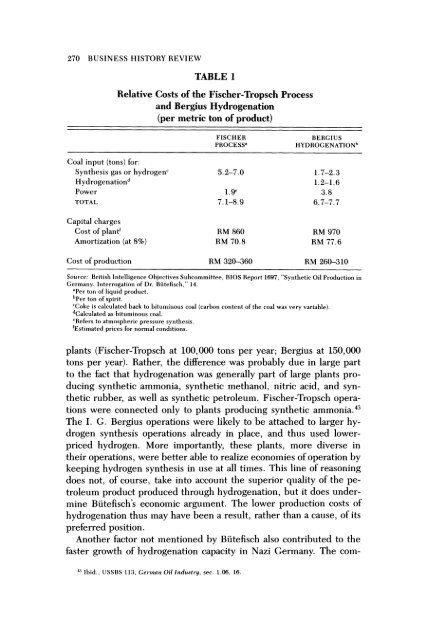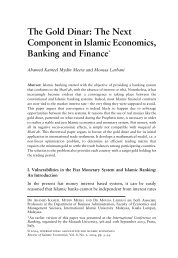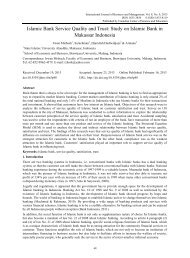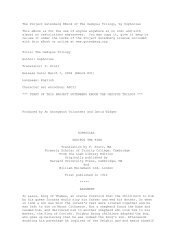The Oil Industry in Nazi Germany, 1936-1945
The Oil Industry in Nazi Germany, 1936-1945
The Oil Industry in Nazi Germany, 1936-1945
Create successful ePaper yourself
Turn your PDF publications into a flip-book with our unique Google optimized e-Paper software.
270 BUSINESS HISTORY REVIEW<br />
TABLE 1<br />
Relative Costs of the Fischer-Tropsch Process<br />
and Bergius Hydrogenation<br />
(per metric ton of product)<br />
FISCHER BERGIUS<br />
PROCESSa HYDROGENATIONb<br />
Coal <strong>in</strong>put (tons) for:<br />
Synthesis gas or hydrogene 5.2-7.0 1.7-2.3<br />
Hydrogenationd<br />
1.2-1.6<br />
Power 1.9e 3.8<br />
TOTAL 7.1-8.9 6.7-7.7<br />
Capital charges<br />
Cost of plantF RM 860 RM 970<br />
Amortization (at 8%) RM 70.8 RM 77.6<br />
Cost of production RM 320-360 RM 260-310<br />
Source: British Intelligence Objectives Subcommittee, BIOS Report 1697, "Synthetic <strong>Oil</strong> Production <strong>in</strong><br />
<strong>Germany</strong>. Interrogation of Dr. Biitefisch," 14.<br />
aPer ton of liquid product.<br />
bPer ton of spirit.<br />
'Coke is calculated back to bitum<strong>in</strong>ous coal (carbon content of the coal was very variable).<br />
dCalculated as bitum<strong>in</strong>ous coal.<br />
eRefers to atmospheric pressure synthesis.<br />
fEstimated prices for normal conditions.<br />
plants (Fischer-Tropsch at 100,000 tons per year; Bergius at 150,000<br />
tons per year). Rather, the difference was probably due <strong>in</strong> large part<br />
to the fact that hydrogenation was generally part of large plants pro-<br />
duc<strong>in</strong>g synthetic ammonia, synthetic methanol, nitric acid, and syn-<br />
thetic rubber, as well as synthetic petroleum. Fischer-Tropsch opera-<br />
tions were connected only to plants produc<strong>in</strong>g synthetic ammonia.43<br />
<strong>The</strong> I. G. Bergius operations were likely to be attached to larger hy-<br />
drogen synthesis operations already <strong>in</strong> place, and thus used lower-<br />
priced hydrogen. More importantly, these plants, more diverse <strong>in</strong><br />
their operations, were better able to realize economies of operation by<br />
keep<strong>in</strong>g hydrogen synthesis <strong>in</strong> use at all times. This l<strong>in</strong>e of reason<strong>in</strong>g<br />
does not, of course, take <strong>in</strong>to account the superior quality of the pe-<br />
troleum product produced through hydrogenation, but it does under-<br />
m<strong>in</strong>e Biitefisch's economic argument. <strong>The</strong> lower production costs of<br />
hydrogenation thus may have been a result, rather than a cause, of its<br />
preferred position.<br />
Another factor not mentioned by Biitefisch also contributed to the<br />
faster growth of hydrogenation capacity <strong>in</strong> <strong>Nazi</strong> <strong>Germany</strong>. <strong>The</strong> com-<br />
4:3 Ibid.; USSBS 113, German <strong>Oil</strong> <strong>Industry</strong>, sec. 1.06, 16.












